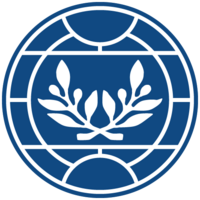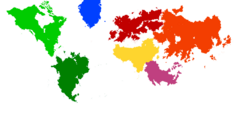Ajax
This article is incomplete because it is pending further input from participants, or it is a work-in-progress by one author. Please comment on this article's talk page to share your input, comments and questions. Note: To contribute to this article, you may need to seek help from the author(s) of this page. |
 | |
| Demonym | Global Worldwide International |
|---|---|
| Countries | 47 (several disputed) |
The world is the combination of the planet and all the life on it. In the context of humanity, the world references the entire collective of human civilization, including all nations, peoples, and societies. It is made up of 7 continents and 5 oceans, containing at least 47 nations.
Continents

Belisaria
Belisaria is a continent located on the Northern Hemisphere, northeast of the Global Center. It is surrounded, clockwise from the North, by the Boreios Sea, the fellow continent Ochran by land, the Periclean Sea, the North Thalassan Ocean, and the Sea of Ghant. It is the western part of the Belisario-Ochrani supercontinent. It is divided from Ochran through the TBD Mountains in its east, and through continuous waterways from the TBA Sea by Thraysia, flowing into the Periclean Sea through to the North Thalassan Ocean. Although not completely its own landmass, Belisaria is accorded its status as a distinct continent given its sprawling size and the important human civilizations that originated and developed there.
It is the fourth largest continent, eclipsed in size by Ochran, Norumbia, and Oxidentale. Its political geography is divided between 18 sovereign nations, of which Cynereth, a historically isolationist and insular country, is the largest. Several other large states include North Ottonia, Latium, Lihnidos, and Arthurista. Collectively, the Belisarian nations have a population of approximately 850 million people. The Belisarian climate, given much of the continent is in the higher latitudes and due to North Thalassan oceanic wind currents is colder and drier, especially in the northwest and north/far north. It is more temperate and cool-to-warm in the central, inland regions of the continent. In the far south along the Periclean coast, it is warm-to-hot, with mild, rainy winters and hot, semi-humid summers.
Belisaria is the birthplace of Hellenic and Latin civilizations in antiquity. Well into ancient history, it had trade and documented ties to Scipia, western Ochran, Ghant, and disputably Norumbia. During the medieval period, the Christianization of Belisaria from former Latinic lands in the south of the continent north and eastward introduced new social values and economic development, while the continental states slowly centralized over the centuries from fractured fiefdoms and small kingdoms into larger empires and trans-continental powers. By the early modern period, exploration, art, and scientific revolutions led to blossoming political ties and trade networks abroad, including the Jade Road in Ochran, the Northern Scipian coastal states, and religious and exploratory expeditions into Norumbia and beyond.
The Industrial Revolution emerged in western Belisaria, and alongside it new economic, political, and social ideas came about from the Arthuristan Illumination, which spread to Scipia, Norumbia, Ochran, and further. The Age of Discovery saw Latin, Arthuristan, and other explorers and traders "fill in the map" to contact to other advanced civilizations in East Ochran and Oxidentale. The 18th, 19th, and early 20th century was characterized by rising nationalism, modernization, and industrialization, including a number of revolutions and wars. In late modernity, Belisaria saw an emerging geopolitical status quo of peace and restraint of use of arms. Currently, the continent enjoys an era of prosperity and stronger intrastate relations.
Ghant
The continent of Ghant is comprised solely of the nation of Ghant, just west of the Global Center of the Northern Hemisphere. It's surrounded, clockwise from the North, by the northern polar ice regions, the Borleis Sea, the Sea of Ghant, and the Northern Thalassan Ocean. It is approximately equidistant between Norumbia and Belisaria. It is the smallest continent, narrowly smaller than Malaio.
The continent-nation of Ghant has a population of approximately 55.5 million. Ghant has a subarctic climate, with long, usually very cold winters, and short, cool to mild summers. Temperatures vary greatly from north to south, with the southern areas having more balanced, temperate seasons then the north.
Ghant is home to the Ghantish culture, a unique and remote society unlike any other, despite later religious and social ties to Belisaria and parts of Norumbia. It is one of the so-called "cradles of civilizations," with a written and oral history dating back perhaps up to 12,000 years old. The continent has folklore and customs dating to antiquity that discuss early kingdoms and alleged supernatural elements in Ghantish prehistory. The historical record suggests the first Ghantish civilization originated in the far south and developed northward over thousands of years. Cold weather, rugged terrain, and uneven crop-growing soil fractured early Ghantish petty states and fiefdoms. By the middle of the medieval period, the first Ghantish state of some power, Kingdom of Low Ghant, in southern Ghant emerged, and developed extensive ties to other fiefdoms to its north and to both Belisaria and Norumbia. Low Ghant's throne was inherited by a Belisarian Ottonian dynasty, which caused political and social tumult. Alongside this, the Black Death hit the continent, causing great population loss and social upheaval.
The continent suffered next under a series of religious wars in the late medieval and early modern era, with conflicting local pagans, Fabrian Catholics, and Protestant Christians all trying to lay claim to Ghantish society. King Samuel V of Low Ghant in the 17th century was crowned the first "King of Ghant" and reconciled the religious divide, as well as pressing north (continued by his descendants) to absorb more independent kingdoms under Low Ghant's rule, which comprised most of the 18th century. In the late 18th and early 19th centuries, Ghant underwent the Industrial Revolution, aided by the unification of the whole continent in 1800 under Nathan I, who took the title Emperor. The century and a half from the dawn of the 19th century until the middle of the 20th century was characterized by numerous civil wars and conflicts between the centralizing monarchy in the south and local "Great Lords" in the center and north of the country.
In the later years of the 20th century and into the 21st century, Ghant has become a settled nation, increasingly looking outwards. Despite its more recent domestic calm and prosperity, it still maintains uneven development by modern standards, with the north in many places still reflecting an almost medieval state of being while the south and coasts are modern and urbanized. It has developed extensive oil deposits inside its borders, becoming a petrostate. Its recent elected leaders have emphasized human rights and self-determination. It is considered by many in the Western Monarchies as a "Great Power."
Ochran
Oxidentale
Malaio
Norumbia
Scipia
Subcontinents
Chersonia
List of Nations in Ajax
| Short and formal names | Capital | Population | Notes |
|---|---|---|---|
| Loweport | 87,565,046 | Parliamentary democracy | |
| Ascalzar | 852,407 | Unitary parliamentary dual monarchy | |
| Gadu | 381,366 | Imperial republic | |
| Thessalona | 110,000,000 | Federal parliamentary constitutional monarchy | |
| Laitstadt | 26,721,750 | parliamentary democracy | |
| Laeleath | 69,243,525 | Theocratic monarchy with limited local democracy | |
| Angrast | 42,132,445 | Unitary parliamentary constitutional republic | |
| Karasuna | 68,783,232 | Federal presidential republic | |
| Fabria City | 1,000 | Parliamentary Constitutional monarchy | |
| Haqara | 35,084,331 | Unitary presidential constitutional republic | |
| Hauptburg | 29,631,654 | Parliamentary constitutional federal monarchy | |
| Ciudad Garza | 7,903,138 | Parliamentary constitutional federal monarchy | |
| Ghish | 55,482,192 | Parliamentary constitutional federal monarchy | |
| Oxonia | 10,431,981 | Unitary parliamentary constitutional monarchy | |
| Villa Romera | 689,242 | republic | |
| Pontiac-Bernadotte | 64,834,000 | Federal parliamentary constitutional diarchy | |
| Kllaiakjè | 7,698,419 | Federal parliamentary republic | |
| Qigiqtaq | 13,432,953 | Direct democratic confederation of freely associated communes | |
| Kalda | 4,957,361 | Unitary absolute monarchy | |
| Castellum ab Alba | 87,216,912 | Unitary parliamentary executive monarchy | |
| Arcadia | 72,420,744 | Unitary parliamentary constitutional monarchy | |
| Lion's Rock | 5,469,700 | Parliamentary republic | |
| Villeneuve | 64,854,527 | Federal constitutional parliamentary democracy | |
| Port du Sol | 37,314,445 | Unitary presidential republic | |
| Kalak'Muul | 119,899,702 | Absolute monarchy | |
| Kronberg | 15,476,339 | Unitary absolute monarchy | |
| Takutaiwhero | 62,010,060 | Federal absolute monarchy | |
| Template:Country data Sudmark – Kingdom of Sudmark | Soddenburg | 9,731,816 | Parliamentary constitutional federal monarchy |
| Karsko | 37,204,940 | Socialist federal Constitutional republic | |
| Roan-Ottonia | 86,568,490 | Presidential democratic republic | |
| Kopiona Poi | 83,452,600 | Confederated Constitutional republic | |
| San Gianpiero | 105,430,000 | Noble Republic | |
| Kæp Jriak | 91,479,732 | Confederated Martial Oligarchy | |
| Sydalon | 14,695,000 | Unitary absolute monarchy | |
| Nashifah | 11,676,115 | Unitary Semi-constitutional monarchy | |
| Konstantinopolis | 94,593,874 | Semi-federal Absolute Monarchy | |
| Tikal City | 248,660 | Parliamentary republic | |
| Magghlessi | 4,563,913 | Technocratic Kritarchy | |
| Asahina | 126,672,000 | Directorial technocratic socialist federal republic | |
| Arimal | 151,852,865 | Igomlaku Federation | |
| Osh | 84,607,593 | semi-federal absolute monarchy | |
| Template:Country data Valgtea – Blessed Republic of Valgtea | Engelhavn | 142,856,836 | Totalitarian socialist theocracy |
| Hrazdan | 51,202,572 | Federal directorial republic | |
| Yerushalayim | 20,204,951 | Federal presidential constitutional monarchy |
